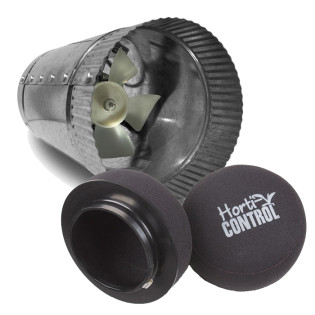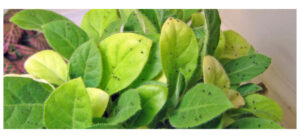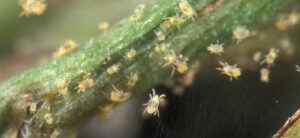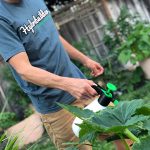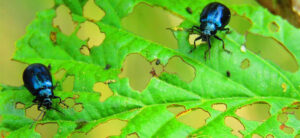
If you have brown discolorations growing on the leaves of your plants, you may be encountering septoria leaf spot, also known as yellow leaf spot.
This unsightly plant disease is obviously cause for concern, but you don’t need to start stressing just yet. It is usually not fatal, but it can prevent your plants from flowering or producing to their potential.
Luckily, we are here to help you identify, prevent, and treat septoria illness should it arise in your garden. Let’s start with some general information, though.
What is septoria leaf spot?
Septoria leaf spot is caused by the Septoria lycopersici fungus. Although it is most commonly found in tomato plants, it can infect just about any other plant in the Solanaceae family.
Most cases of Septoria leaf spot can be brought under control and remedied.
However, if left untreated, it can cause stunted growth and sickly looking plants. In severe cases, it can lead to the death of the plant, but at the very least, it will prevent your plants from flowering properly.
How to detect septoria leaf spot

Due to the nature of this illness, it’s pretty easy to tell when you have Septoria leaf spot. You will notice brown spots on the leaves of your plants.
You might think that the leaves are dying, but this is actually a disease that can be brought under control.
That is, at least, if you take action quickly. Here are some signs to help you diagnose whether or not your plant(s) has Septoria leaf spots.
Starts on Undersides of the Leaves
A telltale sign of septoria leaf spot is the spots are normally found on the undersides of the leaves first. After a while, they will start appearing on the top side of the leaf.
Although there are exceptions, this is where the brown spots usually start. As the disease starts to spread, it will be easily seen from all angles of the leaves. Spotting it when its only on the undersides usually means its early on, and you can treat it relatively easily.
Spots Get Larger & Merge Together

When you first see the brown spots, they will likely be small splotches around your leaves. As they start to get larger and mold together, there will undeniably be a problem that you need to address!
Even as it is just beginning to develop, you will notice the spots grow and grow until they eventually merge together, overtaking an entire leaf. By this point, the issues has evolved to the point where you need to act incredibly quickly if you want to save your plants.
Leaves Eventually Dry Out & Die
As the Septoria leaf spot carries out its natural course, the leaves eventually dry out, wither away, and then die.
Once you start to notice this happening, it’s important to take quick action. Otherwise, the fungus can end up getting out of control and leave you with a dead plant.
Or, at the very least, an unhealthy plant that will never be able to flower properly and result in a dismal yield of low-quality flower.
How To Prevent Septoria Leaf Spot
Like most plant illnesses, preventing septoria leaf spot is super simple. It just comes down to maintaining the ideal grow room environment.
If you keep temperature and humidity in check, you will be far less susceptible to this fungus. Excess moisture, particularly on the leaves themselves, opens up the door for this issue.
This means setting up a ventilation system to help keep moisture and temperatures down. In severe instances, you may need an air conditioner or dehumidifier.
You also need to keep a clean grow room. remove dead plant matter from the vicinity. This includes plant clippings, leaves that fell off, etc.
But sometimes you can do all the right things and still develop an issue with septoria. This is more common outdoors, as its surprisingly common for mold and fungus spores to float to your garden from surrounding areas.
Luckily, we have septoria leaf spot treatment tips to help you regain control of your grow.
Septoria Leaf Spot Treatment - Step by Step Guide
If you are sure that you are battling Septoria leaf spot, it is time to take action. Otherwise, the fungus can get out of control and infect your entire garden.
The last thing you want to do is leave the Septoria leaf spots on your plants and let them develop and grow.
Let’s go ahead and break down the steps involved in getting rid of Septoria leaf spots from home. We’ll start with the easiest, less invasive methods before moving onto fungicides.
1. Manually Remove Infected Leaves
The first thing you should do is manually pick off all the leaves that are infected with the fungus. First, be sure to clean your hands.
Be careful when plucking leaves, as you can agitate fungus spores and shake them onto unaffected leaves, furthering the issue. Gently remove and bag the leaves.
If you want to avoid your skin contacting the fungus, put gloves on. If you don’t use gloves, just be sure to wash your hands afterward with soap and water.
2. Use A Fungicide For Septoria Leaf Spot
Using a fungicide is the best way to kill all of the traces of fungus in the plant. Below, we will break down some of our favorite fungicides.
Some growers have their own thoughts about whether these have a place in the grow room or not.
But, if you use them properly, they can be perfectly safe. And in some instances, they are the difference between salvaging your plants or wasting the last 3 months of time and money.
Usually, the process of applying fungicide is very straightforward. Simply read the manufacturer's instructions and wait for results.
If you get the right fungicide, it will target and kill the fungus all the way down to the plant’s roots. We'll cover this more in a moment.
3. Monitor the Process of Removing the Fungus
Once you start removing leaves and/or using a fungicide, you will quickly begin to notice results.
Usually, results will be very noticeable within a week. If the problem isn’t fully gone within a few weeks, you may need to consider removing the plant altogether to prevent further spread.
Besides, your plant won't yield much if its suffering from this illness anyway.
The best fungicides for removing septoria leaf spot
Now that you know what Septoria leaf spot is, along with how to identify and treat it, you are probably wondering which fungicides work best in combatting it.
Below, we will cover three of our favorite products for removing Septoria leaf spots.
1. General Hydroponics Defguard
One of the best fungicides for septoria leaf spot is General Hydroponics Defguard. This biofungicide and bactericide is OMRI lsited, meaning it is testing and considered organic by the highest possible standards.
It is used not only for leaf spot, but for all kinds of different fungus and mold issues. Some growers will even use it preventatively.
2. Safer Brand 3 in 1 Garden Spray Concentrate
Safer Brand is incredibly reputable in mainstream gardening practices, and kills a variety of different fungi and molds. As it turns out, it does wonders in treating septoria leaf spot!
It is a concentrate, which means you'll need to dilute it in water before spraying. But, this makes it super affordable. In fact, one bottle can cover up to 13,600 square feet!
Safer Brand 3-in-1 contains a powerful mix of potassium salts of fatty acids (insecticidal soap) and sulfur fungicide to quickly eradicate diseases from your foliage.
Like Defguard, it is OMRI listed and completely safe if used properly. It breaks down to its natural state within 10 days, leaving no residual impact on your plants or your grow environment.
3. Organocide Plant Doctor Systemic Fungicide
A third option is Organocide Plant Doctor Systemic Fungicide.
This is a earth-friendly, broad spectrum disease control method for use on all sorts of plants.
It is a systemic fungicide, which means it works its way through the entire plant to fully eradicate the disease you are trying to fight, in this case septoria leaf spot.
But, this fungicide also helps with plant metabolism once inside the plant.
This means it will grow faster, flower heavier, and produce an overall healthier, happier plant. There are not many fungicides out there that can boast this!
Need additional help treating pests and diseases in your garden?
If you are struggling with septoria leaf spot, or any other pest/disease for that matter, you can reach out to our experts at 888-815-9763 or via email here and we will help set you up with an action plan for restoring conditions in your grow room or garden.
If you need anything else for your grow room or garden, such as hydroponic systems, grow tents, or pest control products like the ones we mentioned above, be sure to visit us here at Hydrobuilder.
We are a one-stop-shop for affordable horticulture products. When you shop with us, you’ll experience world class service and the lowest prices online!







